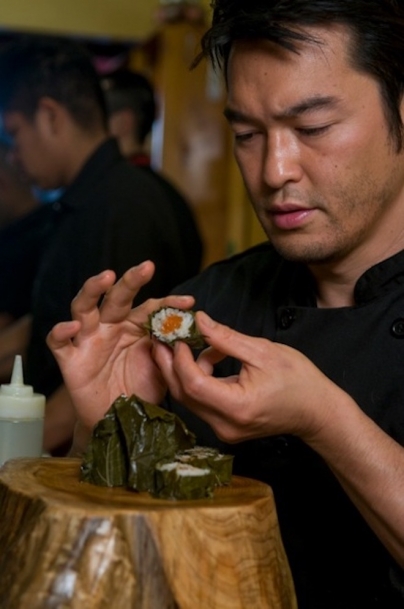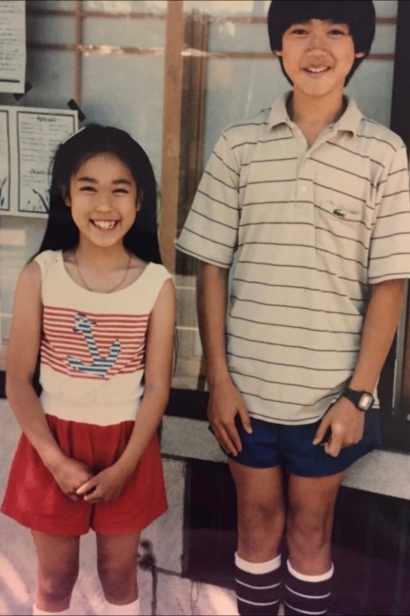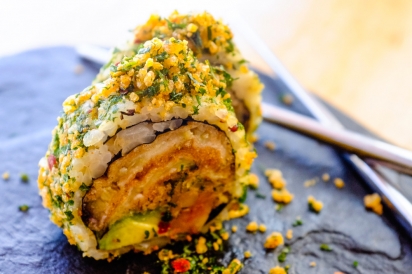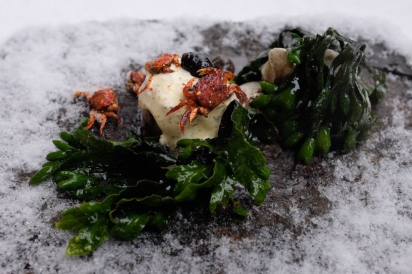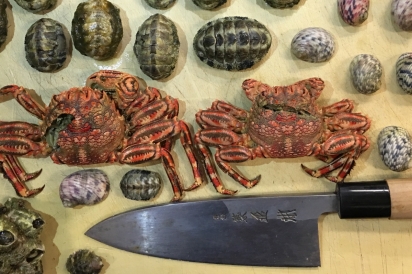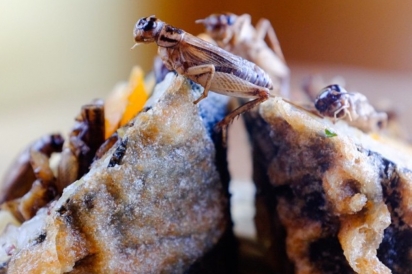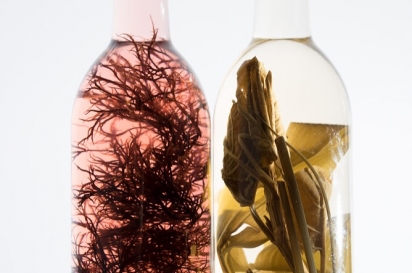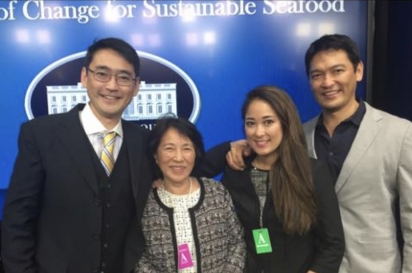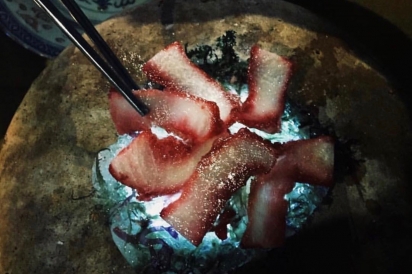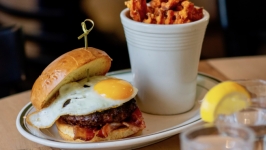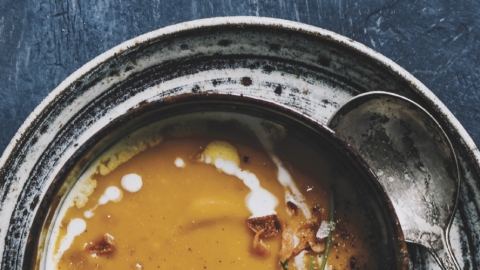On a Roll
In 1982, in an unassuming brick building on Howe Street in New Haven, Yoshiko Lai watched her lifelong dream come to fruition. Yoshiko’s background as a nutritionist and caterer, coupled with her resilient, gender-has-no-barriers attitude, inspired her to open a traditional sushi restaurant. Later, her son, Bun, began experimenting with a sweet potato roll, the first of dozens of combinations of plant-based sushi that would eventually take center stage at Miya’s. Today, Miya’s is seen as a pioneer of the sustainable sushi movement, with Bun continuing to lead the charge. When he’s not behind the counter rolling nori or editing his 20+ page menus, the James Beard Award-nominated chef can be found foraging invasive species off the coast of southern Connecticut in Long Island Sound. Bun put aside his scuba diving gear to give us a glimpse into both his past and passions, as well as provide insight into the state of the modern sushi industry.
On Sushi
Diners typically associate sushi with fish, but your menus are filled with vegetable-based dishes. What drives your unconventional take on the cuisine?
In the late 1990s, when I was a young chef, I started working on plant-based recipes as a healthy alternative to conventional seafood-centered sushi. Today, many of us know that a plant-based diet is one of the healthiest ways to eat. All the longest-living people on Earth, living in what have been called the “Blue Zones,” eat plant-based diets. Most of our plant-based recipes are inspired by Blue Zone cultures. Furthermore, eating a plant-based diet reduces the industrial farming of animals, which, especially with red meat, comes with massive environmental costs in the form of pollution, water use, deforestation, loss of biodiversity, and climate change. In fact, almost 15% of greenhouse gases come from meat and dairy farming, which is more than is produced by all cars, trucks, trains, planes, and ships combined! Cutting back on meat not only ameliorates animal suffering, but it is one big step toward counteracting some of the biggest man-made problems the planet faces today: cancer and climate change.
Sushi’s popularity has caused it to become a ubiquitous part of the food scene. Are there any downsides to the growth of the industry?
Sushi is American today and, as such, has become internationally popular, like pizza and the burger. As a consequence, it is no longer particularly healthy to eat. Many sushi restaurants add sugar to their white rice and generally use other low-quality ingredients in their dishes. For instance, a conventional California roll contains fake crab that is made from “mystery fish,” and when you don't know where the fish is coming from, you can bet that it's not sustainably sourced. That California roll contains no crab at all and is highly processed with sugar, egg whites, and food coloring. Another example is sushi rice, which is white rice with added sugar and most of the fiber and nutrients removed. In light of examples like that, conventional sushi can no longer be categorized as healthy food.
At Miya's, the California Roll Royale is priced at $25, which can give some diners sticker shock. But we use Seafood Watch green-rated Chesapeake Bay blue crab meat that costs $30 a pound, rather than the fake “crab” that costs $3 a pound. The crab in our California Roll Royale costs Miya’s ten times more than what goes into a conventional California Roll, and we are charging only three times more for it.
You’re known for putting unique and exotic things on your menu, including dishes that are centered on invasive species. What drives you to experiment with them?
With $120 billion a year in damage in the U.S. alone, invasive species costs Americans five times more money than McDonald’s annual global sales. There are 50,000 invasive species in the United States. Invasive species may be the greatest untapped sustainable food source we have. Many of them are not only edible, but healthier and tastier than the food we are used to eating. Eating invasive species takes pressure off our industrial agricultural system by shifting the human appetite towards species that are abundant, destructive, and under-utilized. If people ate invasive species instead of cows, we would halt the deforestation of the Amazon Jungle and significantly reduce production of greenhouse gases that lead to climate change. Rather than the usual sushi ingredients, many of which are over-fished or farmed in a way that is destructive to habitats and communities, Miya’s frequently makes use of invasive fish like lionfish, blue catfish, and a plankton-eating Asian carp.
On Miya’s
Your mother founded Miya’s. How do her influences express themselves both in the restaurant and in your own life?
My mother began catering out of a tiny New Haven apartment with only a four-burner electrical stove, years before she started Miya's. She didn't know a thing about the business when she started, but she had tenacity. Her goal was to start a restaurant and make it work, no matter what. From my mother, I learned to be optimistic, to ignore the naysayers, and to never give up.
My father is an MD with two PhDs from Cambridge University. His first job in the United States was at Yale Medical School, where he did research. His life purpose has been to make the world a better place through his work, which influenced my own work. As a young chef, because of my dad, I always knew that it was not enough to make tasty and beautiful food. I aspired to make food that mattered.
Have you received any criticism or pushback from what you serve?
I spent the first two decades of my career “broke as a joke,” for many years, living in the basement of Miya's, with people telling me what I created wasn't sushi. I didn't agree with them, because food is culture, and cultures evolve. I knew our work at Miya's was part of an evolution. What I didn't know then was that it was the spark that helped start a revolution in the cuisines of sushi. Today, sustainable sushi is a growing, world-wide movement, and it all started in a little restaurant in New Haven, Connecticut.
On the Environment
How has climate change affected our waters close to home? What changes have you noticed?
As the waters of Long Island Sound have become warmer, blue crabs have moved in, causing lobster populations to plummet, and fish more commonly found in the mid-Atlantic have been appearing. Nobody knows what species will be here next, and many of them may be invasive. There is a direct connection between the proliferation of invasive species and climate change. As our region’s water becomes warmer, new species move in to take advantage of it, and many of them may cause irreparable harm to this area’s native species. One day, if we have coconuts growing on Long Island, we will likely also have invasive lionfish. In fact, they have already been spotted here, along with sea horses and manatee. Furthermore, as the oceans sequester more carbon dioxide and become more acidic, we may one day have no remaining shellfish in the Sound. Our region's most-iconic fisheries – clams and oysters – may one day be gone for good.
When did you first start serving invasive species, and what complexities are involved in the process?
In 2001, Yancey Orr (then, an undergraduate at Yale University) and I noticed little crabs that we had never seen before, which we identified as an invasive species, Asian shore crab. Today, Yancey is a professor of environmental anthropology, and we have been working on invasive species as a food source ever since. It's been slow moving to source them. Just because you can catch them does not mean you can serve them at a restaurant. There are all sorts of complex laws and regulations that have to be addressed. That's the reason we can't get nutria from Louisiana or wild boar from Florida, though we should be eating them. Our food system is just starting to recognize invasive species as the ultimate untapped sustainable food resource, and is beginning to make them available to chefs and consumers. However, much still needs to still be done before we can really take advantage of this bounty.
Outside of Miya’s, what sorts of eco-friendly practices have you established at home and in your day-to-day life?
Plant-based eating, supplemented by ethically sourced food animals, along with the three R's: reuse, reduce, recycle. If I could amend the three R's by adding another, it would be R for REMINDER. It's important to remind ourselves that every choice we make impacts other people and living things, both nearby and far away.
> Miya's: 68 Howe St., New Haven; 203-777-9760


